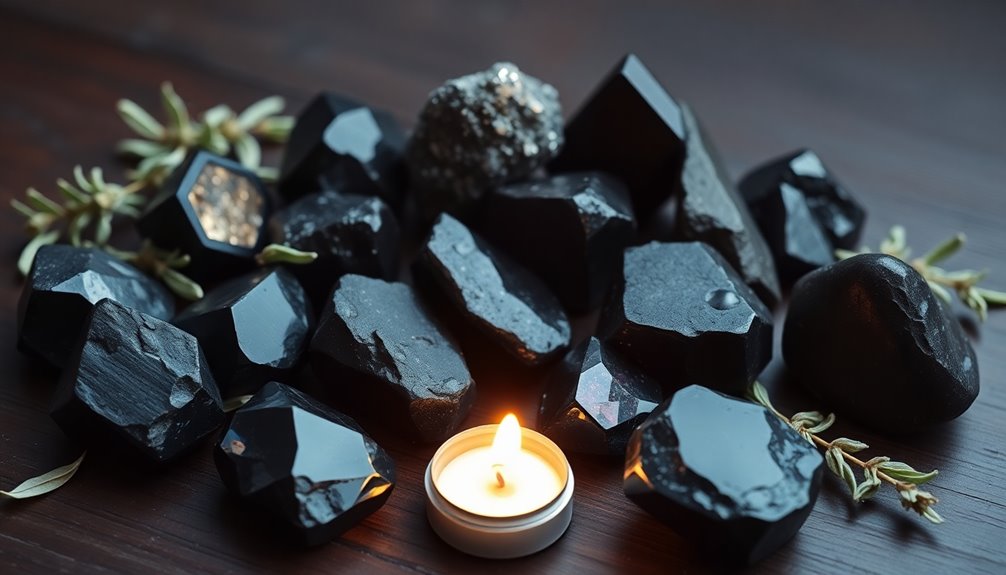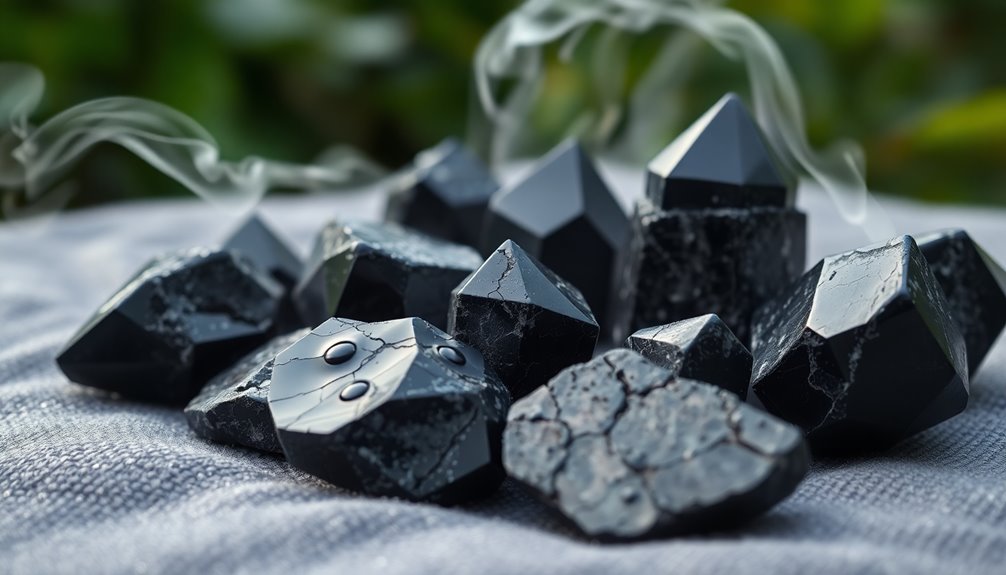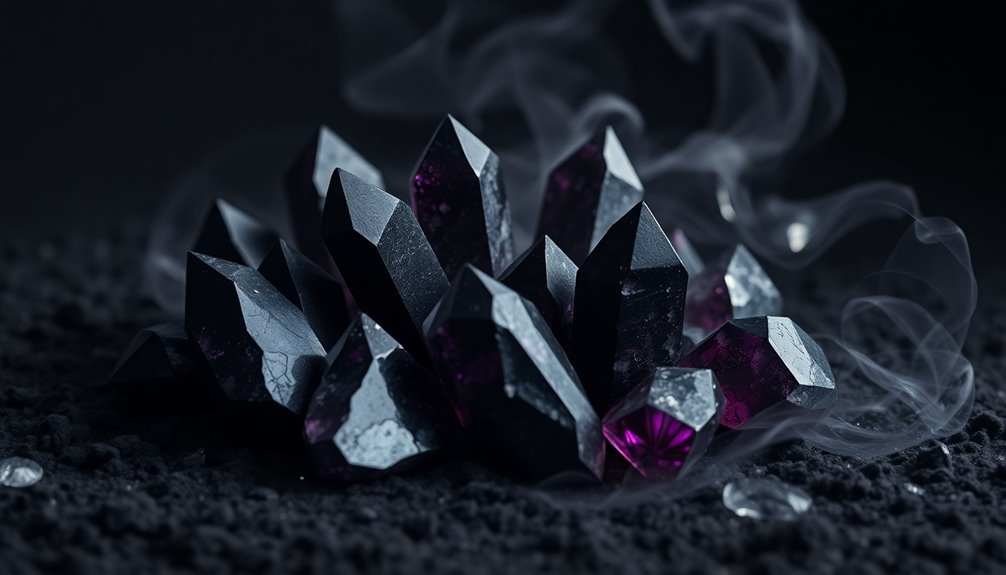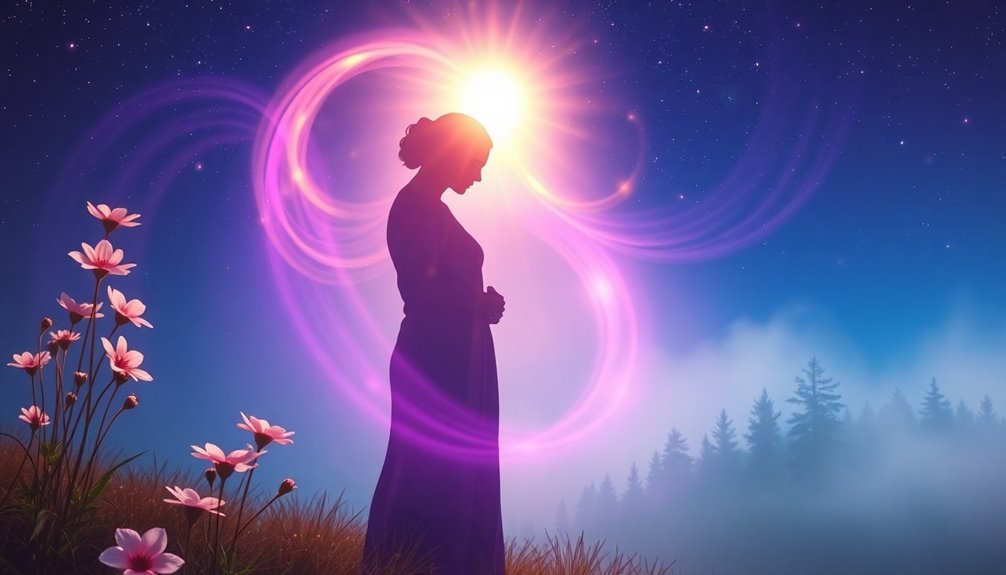Black crystals like Black Tourmaline, Obsidian, and Hematite are powerful allies for your emotional and spiritual health. These gems absorb negative energy, promote grounding, and enhance emotional stability. Black Tourmaline purifies energies, while Obsidian helps uncover hidden emotions and blocks negativity. Use Onyx for strength and confidence, and try Shungite for its purifying qualities. Regular cleansing is essential to maintain their powers, so be sure to rinse them in water or expose them to moonlight. By integrating these crystals into your life, you'll access their unique spiritual benefits, and there's so much more to explore about their uses!
Key Takeaways
- Black Tourmaline: Known for purifying and repelling negativity, it promotes grounding and emotional healing.
- Obsidian: Aids in uncovering hidden emotions, blocks negative influences, and supports emotional healing.
- Onyx: Provides strength and emotional stability by absorbing negative energy, enhancing resilience.
- Hematite: Enhances self-confidence and balances body and mind, making it essential for grounding.
- Shungite: Renowned for its purifying properties, it supports both physical and emotional health.
Overview of Black Crystals

Black crystals are fascinating and powerful tools in the world of healing and spirituality. Known for their protective properties, these crystals effectively absorb negative energies, helping you maintain emotional stability.
Two popular black crystals you might encounter are Black Tourmaline and Obsidian. Black Tourmaline purifies and repels negativity, while Obsidian aids in emotional healing and helps uncover hidden emotions.
These crystals are often linked to the root chakra, enhancing your connection to the Earth and providing a sense of security and safety. Incorporating black crystals into your spiritual practices can greatly enhance your grounding experience. Whether you're meditating or simply seeking peace, these stones can help anchor you.
Regular cleansing is essential to maintain the energy of your black crystals. You can cleanse them by rinsing with water or exposing them to moonlight.
Other black gemstones like Black Onyx and Shungite are also popular in jewelry, offering protection and supporting personal growth. By understanding the qualities of black crystals, you can harness their energy for a more balanced and stable life.
Spiritual Powers of Black Crystals

Renowned for their protective qualities, black crystals offer powerful spiritual benefits that can transform your journey. Stones like Black Tourmaline and Black Obsidian shield you against negative energies and psychic attacks, creating a safe space for your personal growth.
These crystals enhance grounding, connecting you to the Earth's energies, which promotes emotional balance, particularly through the alignment of your Root Chakra.
Additionally, black crystals like Hematite and Shungite absorb and transmute negative emotions, purifying your environment and fostering overall well-being. When you work with these stones, you'll find that they not only protect but also empower you during challenging times, aiding in resilience and self-control.
The unique properties of black crystals facilitate deeper meditation practices by clearing mental blockages and enhancing your spiritual awareness.
As you explore meditation, these stones can become invaluable tools for healing and transformation. By incorporating black crystals into your spiritual practice, you'll reveal their profound potential, allowing for a more balanced and empowered life.
Embrace the power of these black gemstones and let them guide you on your path to self-discovery and personal evolution.
Popular Black Crystals and Their Uses

When exploring the world of black crystals, you'll discover a variety of stones, each with unique properties and uses that can enhance your spiritual journey.
Here are some popular black crystals you might consider incorporating into your life:
- Black Tourmaline: Known for its protective properties, it effectively purifies and repels negative energy while promoting grounding and stability.
- Obsidian: This natural volcanic glass helps uncover hidden emotions and blockages, making it a powerful tool for personal growth and emotional healing.
- Onyx: Often used in jewelry, Onyx provides strength during challenging times, absorbs negative energy, and offers emotional support.
- Hematite: With its metallic sheen, Hematite is associated with grounding and stability, enhancing self-confidence and balancing the body and mind.
Healing Properties of Black Crystals

Many people turn to black crystals for their remarkable healing properties, especially when seeking protection from negative energies. These gemstones, like Black Tourmaline and Black Obsidian, are renowned for their protective properties, effectively shielding you from psychic attacks and harmful influences. By absorbing and transmuting negative emotions, black crystals promote emotional balance, aiding your personal growth.
Many of these crystals are linked to the root chakra, which helps ground your energy and enhance stability during stressful times. This grounding effect is vital, as it connects you to the Earth and fosters resilience. In your spiritual practices, incorporating black crystals can deepen your connection to your intentions and enhance your overall well-being.
Regular cleansing of your black crystals is essential to maintain their healing powers. Rinsing them with water or exposing them to moonlight helps remove stagnant energies, ensuring they remain effective.
Additionally, gemstones like Hematite and Shungite not only provide emotional support but also enhance your physical well-being by promoting circulation and alleviating stress-related ailments.
Embrace the healing properties of black crystals to support your journey toward balance and stability.
Care and Maintenance Tips

To keep your black crystals in top shape, regular cleansing is key.
Use gentle methods like rinsing them under water or letting them soak in moonlight, and always store them in a soft pouch to prevent scratches.
Remember to steer clear of harsh chemicals to protect their natural energy and vibrational qualities.
Regular Cleansing Methods
Regularly cleansing your black crystals is essential for maintaining their energetic properties and keeping them free from negative energies. By doing so, you enhance their protective and grounding abilities, guaranteeing they effectively support your spiritual journey.
Here are some effective cleansing methods to contemplate:
- Running Water: Rinse your crystals under running water for a few minutes to clear away stagnant energy and promote purification.
- Moonlight: Place your crystals outside or near a window during a full moon to recharge their vibrational energy and strengthen their spiritual connection.
- Sound Cleansing: For crystals like Shungite, use sound tools such as singing bowls or bells to enhance the cleansing process and elevate their energy.
- Avoid Harsh Chemicals: Steer clear of using any harsh chemicals or exposing brittle crystals to prolonged sunlight, as this can damage their structure or fade their colors.
Regular cleansing is recommended, especially after intense use, to guarantee your black crystals remain potent in providing protection and grounding.
Keep these methods in mind, and your crystals will continue to support your spiritual endeavors effectively.
Proper Storage Techniques
Properly storing your black crystals is vital for their longevity and effectiveness. To maintain their unique properties and energy, choose a cool, dry place away from direct sunlight. This is especially important for delicate stones like Black Moonstone and Obsidian, which can fade or sustain damage if exposed to harsh conditions.
Use natural materials like silk or cotton pouches to protect your crystals from scratches and physical harm. These gentle storage solutions guarantee your crystals remain in peak condition for energy work.
When organizing your collection, consider creating a designated space such as a crystal grid or display shelf. This not only helps you keep track of your crystals but also enhances their energetic properties.
While cleaning your crystals, remember to avoid harsh chemicals that can degrade their surfaces. Instead, opt for gentle methods like rinsing them with water, placing them under moonlight, or using sound vibrations.
Regular maintenance is key to preserving the energy and effectiveness of your black crystals, so implement these proper storage techniques to make sure they serve you well for years to come.
Avoiding Harsh Chemicals
Your black crystals deserve gentle care to maintain their beauty and energy. Regular cleansing is essential to remove absorbed negative energies, but using harsh chemicals can damage their surface and diminish their natural properties.
To protect your crystals' integrity, follow these simple care tips:
- Use a damp cloth for cleaning instead of chemical solutions.
- For brittle black crystals like Black Moonstone or Shungite, avoid water altogether to prevent brittleness and damage.
- Expose your black crystals to moonlight to safely recharge their energy without risking chemical reactions.
- Always check the specific care instructions for each type of black crystal, as some may require extra gentle handling.
How to Use Black Crystals

Harnessing the power of black crystals can considerably enhance your spiritual and emotional well-being. To begin, incorporate black crystals into your meditation practices. Hold them in your hand or place them on your body to promote grounding and emotional stability. This connection strengthens your protective barrier against negative energies, allowing for clarity and peace during your sessions.
Wearing black crystal jewelry, like necklaces or bracelets, guarantees you benefit from their protective properties throughout the day. These crystals absorb and transform negative energies, keeping you centered and secure.
For your home, strategically place black crystals in entryways or meditation spaces to create a protective barrier, fostering a harmonious environment.
Regularly cleansing your black crystals is vital for maintaining their effectiveness. Rinse them with water or expose them to moonlight to refresh their energy.
Additionally, when focusing on chakra balancing, pay particular attention to the root chakra. This practice enhances your grounding and stability, facilitating personal growth and resilience.
Black Crystals in Meditation

When you incorporate black crystals into your meditation practice, you can experience grounding that keeps you anchored in the moment.
These stones not only enhance your intuition and clarity but also provide protection from distractions.
Grounding Meditation Practices
Grounding meditation practices can greatly enhance your sense of stability and connection to the Earth. By incorporating black crystals, like Black Tourmaline and Obsidian, you can effectively absorb negative energies and create a calming environment.
These crystals resonate with your Root Chakra, promoting focus and clarity during your sessions.
To maximize the benefits of grounding meditation, consider these practices:
- Hold or place black crystals around your meditation space to create a protective barrier against distractions.
- Engage in regular cleansing of your crystals to maintain their energetic potency for effective grounding.
- Use black crystals for emotional healing, uncovering and transforming hidden emotions, fostering personal growth and resilience.
- Visualize your connection to the Earth, allowing the energy of the black crystals to anchor you during your meditation.
Enhancing Intuition and Clarity
Black crystals serve as powerful tools for enhancing your intuition and clarity during meditation. When you incorporate crystals like Black Obsidian and Black Kyanite, you create a protective space that encourages deep reflection. This environment allows you to tap into your intuitive abilities without distractions.
Using Black Tourmaline helps with grounding energy, shielding you from any external negative influences, which in turn fosters clearer focus and insight. Smoky Quartz is excellent for dispelling mental fog, promoting emotional calmness, and facilitating a stronger connection to your inner wisdom.
For those seeking emotional balance during meditation, Black Moonstone is invaluable. Its lunar energy enhances your intuition, guiding you toward clarity in your self-reflection practices.
Integrating black crystals into your meditation routine amplifies your intention-setting efforts. Their grounding properties stabilize your energy, helping you channel focused thoughts into actionable insights.
With these crystals, you can deepen your meditation experience, revealing new levels of understanding and awareness. Embrace the unique spiritual powers of black crystals and watch as your intuition and clarity flourish.
Protection During Meditation Sessions
Incorporating black crystals into your meditation practice not only enhances intuition but also provides an essential layer of protection. Crystals like Black Tourmaline and Obsidian create a protective barrier against negative energies, allowing you to dive deeper into your meditation sessions.
When you hold or place these crystals nearby, they help ground your body, enhancing emotional stability and promoting calmness.
Consider these benefits of using black crystals during meditation:
- Protective barrier against negative energies
- Grounding your energy, connecting with your root chakra
- Absorb negative emotions and transmute them into positive energy
- Regular cleansing guarantees effectiveness and protective qualities
Community and Learning Resources

Exploring the world of black crystals opens up a wealth of community and learning resources designed to enhance your experience and knowledge.
You'll find numerous online courses that focus on the properties and uses of black crystals, including specialized topics like Crystal Healing and Reiki. These learning resources help deepen your understanding of their spiritual powers.
Engaging with the community is equally rewarding. Many initiatives offer free samples of popular courses, inviting you to explore the benefits of black crystals in various practices.
Regular newsletters keep you updated on new product arrivals, special offers, and educational content about ethical sourcing and the metaphysical properties of these powerful stones.
Participating in workshops and local events promotes discussions that foster personal growth and collective knowledge among crystal enthusiasts.
Here, you can learn about the usage and care of black crystals while connecting with others who share your passion. Supporting ethical sourcing practices also contributes to responsible practices in the crystal industry, benefiting local miner communities.
Frequently Asked Questions
Which Black Crystal Is the Most Powerful?
When you're wondering which black crystal is the most powerful, it really depends on your needs.
Black Tourmaline's protective qualities make it a favorite for warding off negative energies, while Obsidian helps uncover deep emotional blockages.
If you're looking for grounding, Hematite offers stability and clarity.
Each crystal has unique strengths, so consider what resonates with you personally to find the one that truly empowers your journey.
Trust your intuition!
What Are Some Names of Black Crystals?
You'll find several striking black crystals, each with its own unique qualities.
Black Tourmaline is a great choice for protection against negativity.
Obsidian helps you uncover hidden emotions, while Black Onyx boosts your strength and stamina during tough times.
Hematite offers grounding and stability, enhancing your self-confidence.
Finally, Shungite is known for purifying and protecting against electromagnetic radiation.
Explore these crystals to discover which resonates with you the most!
What Powers Do Black Stones Have?
Black stones offer a range of powerful benefits.
You'll find that Black Tourmaline protects against negative energies, creating a barrier around you.
Obsidian helps you uncover hidden emotions, promoting personal growth.
If you seek strength, Black Onyx boosts your stamina during tough times, transforming negativity into positivity.
Hematite grounds you, balancing your mind and body while enhancing self-confidence.
Finally, Shungite purifies your environment, absorbing harmful radiation for emotional and physical healing.
What Is the Black Crystal That Changes Your Life?
Imagine holding a piece of volcanic glass in your hand; that's Obsidian.
This black crystal can change your life by helping you uncover hidden emotions and blockages. As you work with it, you'll promote personal growth and emotional healing.
It's like having a mirror that reflects your inner self, allowing you to face challenges head-on. Embrace its power, and you'll find transformation in your journey toward self-discovery and resilience.
Conclusion
In exploring the world of black crystals, you've tapped into a reservoir of spiritual strength and healing. These gems, like shadows dancing in the moonlight, offer protection and grounding energy that can enrich your journey. Remember to care for them, as they care for you. Whether you're meditating or simply keeping them close, let their unique powers illuminate your path. Embrace their magic, and watch how they transform your life, one spark at a time.









